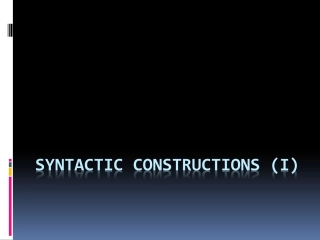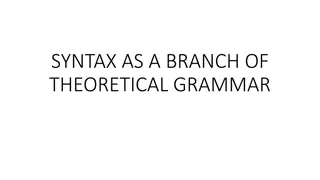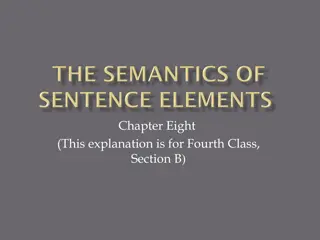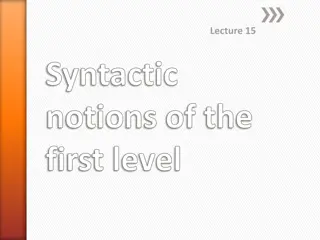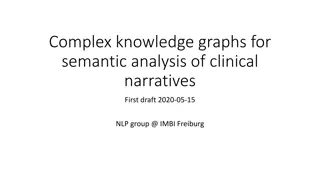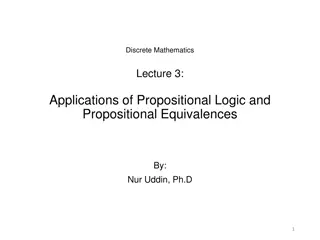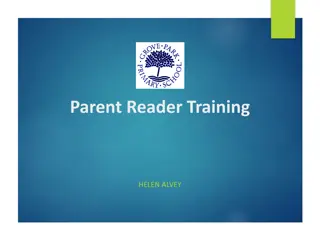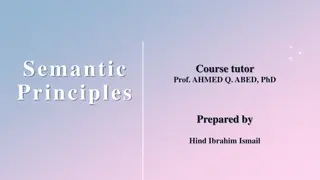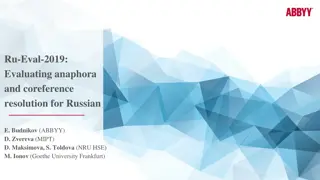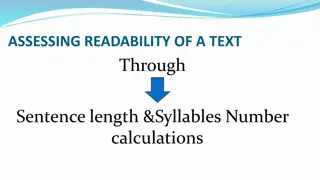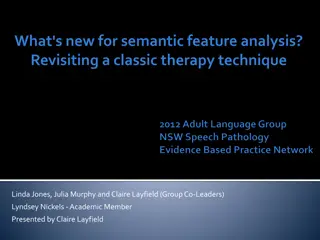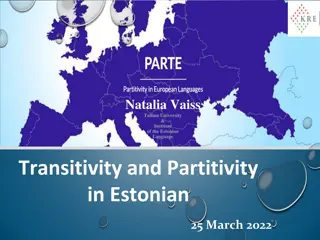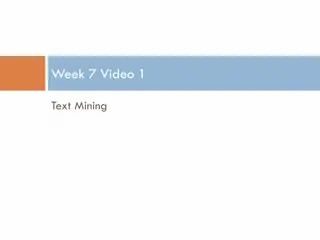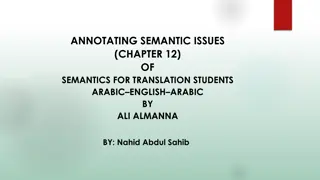Analysis of Syntactic Structures and Semantic Equivalences in *FOG Text
The analysis delves into the syntactic structures and semantic equivalences present in the *FOG text. It explores the positioning of "fog" in different lines, the verbless nature of simple and complex sentences, and the equivalence in prepositional phrases and lexical choices. The study examines how the text conveys meaning through syntactic constructions and semantic relationships.
Download Presentation

Please find below an Image/Link to download the presentation.
The content on the website is provided AS IS for your information and personal use only. It may not be sold, licensed, or shared on other websites without obtaining consent from the author.If you encounter any issues during the download, it is possible that the publisher has removed the file from their server.
You are allowed to download the files provided on this website for personal or commercial use, subject to the condition that they are used lawfully. All files are the property of their respective owners.
The content on the website is provided AS IS for your information and personal use only. It may not be sold, licensed, or shared on other websites without obtaining consent from the author.
E N D
Presentation Transcript
*FOG Text Analysis
Equivalent syntagmatic/syntactic position of fog in lines 1-11 whereas there is a change in position in lines 12-14. *Position
All simple sentences are verbless, while all complex sentences have verbless main clauses, consequently a predominantly nominal style. *Verbless
Lines 1-4. There is a short verbless simple sentence introducing two successive, syntactically equivalent complex sentences. Note the semantic opposition of the prepositional phrases in the principal clauses (up the river/down the river), the same number of syllables in the main clauses and the equivalent phonetic/syntacvtic opening of the two subordinate Clauses (where it flows/where it rolls). *Equivalence
Lines 4-5: An exactly-balanced, verbless compound, both parts introduced by the subject fog, zero verb, and equivalent prepositional phrases of place. Note the semantic equivalence of Essex marshes/Kentish heights and consider whether the positionally equivalent (f) phonemes in marshes and Kentish are casual or non-casual. *Equivalence 2
Lines 5-7: A sentence divided into three by the use of semi-colons, the first and third parts being simple sentences offset by a longer compound in the middle. Each sentence consists of the subject fog followed by equivalent predicate structures of zero auxiliary, present participle and prepositional phrase. *Syntactic equivalence
The series of prepositional phrases, apart from their syntactic/positional equivalence, are also the environment for a series of lexical equivalences in that cabooses of collier brigs, yards, rigging of great ships and gunwales of barges and small boats are all taken from the same semantic domain (shipping). *Lexical equivalence
Again phonetic equivalence is evident due to the equivalent syntactic structures used, particularly the nasals but also the number of /s/ fricatives which may just be casual usage determined by the syntactic choice of plural substantives or it may be a non-casual usage which would connect up with the use of (f) fricatives in the previous sentence. *Phonetic equivalence
*Lines 8-12. Once again, a long sentence divided into three parts by means of semi-colons. This time, however, the first two parts are equivalent complex sentences followed by a simple sentence. *Sentences
*Again, the main clauses are all verbless whiloe the two subordinates have zero for the relaive pronoun and verb: wheezing = who are wheezing , down = who is down . *Verbless
Note also the exact syntactic/semantic/positional equivalence of the first two main clauses (subject + zero verb + preposition + noun + noun + preposition + qualifier + noun) in which the first nouns in all three sentences are component parts of the third noun, which is itself each time semantically equivalent, with age and years of service being the only distinctive components. *Syntactic/semantic equivalence
Lines 12-15. Note sudden change of subject. Fog is no longer highlighted in the subject position in the syntagm but rather the noun phrase chance people. Consider also the relevance of the phonological equivalence established by the plosives in people on the bridges peeping over the parapets. *Change of subject
Check in the dictionary the word nether and contrast its denotative meaning with its connotations that are to be found in contexts like nether worlds or nether regions. Note again the shift from places Fog everywhere to people fog all around them. *Nether
Finally, consider the analogy between the people in the city covered in fog and people in a balloon in the clouds. Note the metaphorical nether sky of fog and the simile introduced by as if. *Analogy
Compare the last metaphors with the simple metaphors of lines 5-7, fog creeping, fog hovering and fog drooping, as well as the figurative use of the verb to pinch in line 11. *Metaphor
The use of Fog creates the atmosphere and reflects its all-pervading presence. There is a progression from everywhere, going from the countryside to the dirty city and then specifically to the decks, and then the shift to people with fog all around them. (like a zoom lens) *Comment


